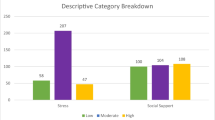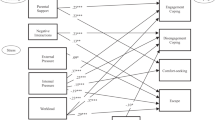Abstract
It has been suggested that some proportion of minority adolescents' high risk for school failure is associated with their increased exposure to the stressors often associated with low-income status—more specifically, with their residence in resource-poor communities—including poverty, racism, conflict, and violence. However, to date, little research has documented the nature of such stress. This descriptive study attempts to begin filling this gap in the literature by examining the nature of stress in the lives of 158 urban, low-income, Mexican-American high school sophomores. While these adolescents experienced stressors that are characteristic of their developmental level, their report of many severe stressors reflect the circumstances of their resource-poor communities. Generally, males and females endorsed equal numbers of stressors both overall and within various contexts. However, gender differences were observed in terms of the kinds of stressors these groups experienced. In examining the relationship between stressors and academic achievement, gender differences also were revealed in the types of stressors that are related to concurrent grade point average. Contrary to much of the literature that establishes a relationship between stress and social support, the presence of caring and emotional support was not sufficient to offset the negative effects of stress for this urban, low-income, minority sample.
Similar content being viewed by others

REFERENCES
Alvidrez, J., and Weinstein, R. S. (1993). The nature of schooling in school transitions: A critical re-examination. Prev. Human Serv. 10: 7–26.
Benson, L. T., and Deeter, T. E. (1992). Moderators of the relation between stress and depression in adolescents. School Couns. 39: 189–194.
Berndt, T., and Savin-Williams, R. (1993). Peer relations and friendships. In Tolan, P., and Cohler, B. (eds.), Handbook of Clinical Research and Practice with Adolescents. New York: Wiley.
Blechman, E. A. (1992). Mentors for high-risk minority youth: From effective communication to bicultural competence. J. Clin. Child Psychol. 21(2): 160–169.
Brand, A. H., and Johnson, J. H. (1982). Note on reliability of the life events checklist. Psychol. Rep. 58(3): 1274.
Bryk, A. S., Lee, V. E., and Smith, J. B. (1990). High school organization and its effects on teachers and students: An interpretive summary of the research. In Clune, W. J., and Witte, J. F. (eds.), Choice and control in American education. Vol. 1: The theory of choice and control in American education (pp. 135–226). Philadelphia: The Falmer Press.
Carney, T. F. (1972). Content Analysis: A Technique for Systematic Inference from Communications. University of Manitoba Press, Manitoba.
Cauce, A. M. (1989). Social Support Rating Scale Revised. Unpublished manuscript.
Cauce, A. M., Hannan, K., and Sargeant, M. (1992). Life stress, social support, and locus of control during early adolescence: Interactive effects. Am. J. Commun. Psychol. 20: 787–798.
Causey, D. L., and Dubow, E. F. (1993). Negotiating the transition to junior high school: The contributions of coping strategies and perceptions of the school environment. Prev. Human Serv. 10: 59–81.
Chavez, E. L., Oetting, E. R., and Swaim, R. C. (1994). Dropout and delinquency: Mexican-American and Caucasian non-Hispanic youth. J. Clin. Child Psychol. 23(1): 47–55.
Chicago Panel on Public School Policy and Finance (1994). Chicago Public Schools Data Book. School Year 1992–93.
Children's Defense Fund. (1987). A children's defense budget. Washington, D.C.: Children's Defense Fund.
Cohen, S. (1991). Stress during childhood and adolescence: Sources of risk and vulnerability. In Cummings, E. M., Greene, A. L., and Karraker, K. H. (eds.), Life-Span Developmental Psychology: Perspectives on Stress and Coping. Erlbaum, Hillsdale, NJ.
Cole, P. S. (1992). A longitudinal study of stress, coping, substance use and minor delinquency among young adolescents in an urban school. Unpublished doctoral dissertation, Yale University, New Haven, CT.
Conger, J. J., and Petersen, A. C. (1984). Adolescence and youth: Psychological development in a changing world (3rd edition). Harper Row: New York.
Cox, D. R. (1981). Applied Statistics: Principles and Examples. Chapman and Hill, New York.
Crockett, L. J., Petersen, A. G., Graber, J. A., Schulenberg, J. E., and Ebata, A. (1989). School transitions and adjustment during early adolescence. J. Early Adolesc. 9: 181–210.
Dornbusch, S. M., Mont-Reynaud, R., Ritter, P. L., Chen, Z., and Steinberg, L. (1991). Stressful events and their correlates among adolescents of diverse backgrounds. In Colten, M. E., and Gore, S. (eds.), Adolescent Stress: Causes and Consequences, de Gruyter, Hawthorne, NY.
DuBois, D. L., Felner, R. D., Brand, S., Adan, A. M., and Evans, E. G. (1992). A prospective study of life stress, social support, and adaptation in early adolescence. Child Develop. 63: 542–557.
DuBois, D. L., Felner, R. D., Meares, H., and Krier, M. (1994). Prospective investigation of the effects of socioeconomic disadvantage, life stress, and social support on early adolescent adjustment. J. Abnorm. Psychol. 103: 511–522.
Duncan, G. J., Brooks-Gunn, J., and Klebanov, P. K. (1995). Economic deprivation and early childhood development. Child Develop. 65: 296–318.
Eccles, J. S., Midgley, C., Wigfield, W. D., Buchanan, C. M., Reuman, D., Flanagan, C., and MacIver, D. (1993). Development during adolescence: The impact of stage environment fit on young adolescents' experiences in schools and in families. Am. Psychol. 48(2): 90–101.
Elias, M. J., Ubriaco, M., Reese, A. M., Gara, M. A., Rothbaum, P. A., and Haviland, M. (1992). A measure of adaptation to problematic academic and interpersonal tasks of middle school. J. School Psychol. 30: 41–57.
Felner, R. D., and Adan, A. M. (1988). The school transitional environment project: An ecological intervention and evaluation. In Price, R. H., Cowen, E. L., Lorion, R. P., and Ramos-McKay, J. (eds.), Fourteen Ounces of Prevention: A Casebook for Practitioners. American Psychological Association, Washington, DC., pp. 111–137.
Felsten, G., and Wilcox, K. (1992). Influences of stress and situation-specific mastery beliefs and satisfaction with social support on well-being and academic performance. Psychol. Rep. 70: 291–303.
Garbarino, J. (1980). Some thoughts on school size and its effects on adolescent development. J. Youth Adolesc. 9: 19–31.
Garbarino, J., Kostelny, K., and Dubrow, N. (1991). What children can tell us about living in danger. Am. Psychol. 46: 376–383.
Gore, S., and Aseltine, R. H. (1995). Protective processes in adolescence: Matching stressors with social resources. Am. J. Commun. Psychol. 23(3): 301–328.
Harrison, A. O., Wilson, M. N., Pine, C. J., Chan, S.Q., and Buriel, R. (1990). Family ecologies of ethnic minority children. Child Develop. 61: 347–362.
Hays, W. L. (1988). Statistics (4th Ed.). Holt, Rinehart, and Winston, Fort Worth, TX.
Hill, M. S., and Sandfort, J. R. (1995). Effects of childhood poverty on productivity later in life: Implications for public policy. Child. Youth Serv. Rev. 17: 91–126.
Johnson, J. H. (1982). Life events as stressors in childhood and adolescence. In Lahey, B. B., and Kazdin, A. E. (eds.), Advances in Clinical Child Psychology (Vol. 5), Plenum Press, New York, pp. 219–253.
Johnson, J. H., and McCutcheon, S. M. (1980). Assessing life stress in older children and adolescents: Preliminary findings with the Life Events Checklist. In Sarason, L. G., and Spielberger, C. D. (eds.), Stress and Anxiety (Vol. 7). Hemisphere, Washington, DC.
Kelly, J. G., Ryan, A. M., Altman, B. E., and Stelzner, S. P. (1993). Understanding and changing social systems: An ecological view. In Seidman, E., and Rappaport, J. (eds.), Handbook of Community Psychology. Plenum Press, New York.
Kyle, C. L. (1984). Los Preciosos: The Magnitude of and Reasons for the Hispanic Dropout problem in Chicago: A Case Study of Two Chicago Public High Schools. Unpublished doctoral dissertation, Northwestern University, Evanston, IL.
Leadbeater, B. J., Blatt, S. J., and Quinlan, D. M. (1995). Gender-linked vulnerabilities to depressive symptoms, stress, and problem behaviors in adolescents. J. Res. Adolesc. 5: 1–29.
Lee, V. E., Bryk, A. S., and Smith, J. B. (1993). The organization of effective secondary schools. In Darling-Hammond, L. (ed.), Review of Research in Education (Vol. 19). American Educational Research Association, Washington, DC, pp. 171–267.
Licitra-Kleckler, D. M., and Waas, G. A. (1993). Perceived social support among high-stress adolescents: The role of peers and family. J. Adolesc. Res. 8(4): 381–402.
Lloyd, D. N. (1978). Prediction of school failure from third grade data. Educ. Psychol. Meas. 38: 1193–1200.
Luthar, S. S. (1991). Vulnerability and resilience: A study of high-risk adolescents. Child Develop. 62(3): 600–616.
Martinez, C. (1988). Mexican-Americans. In Comas-Diaz, L., and Griffith, E. H. (eds.), Clinical Guidelines in Cross-Cultural Mental Health. Wiley, New York, pp. 182–203.
Meichenbaum, D. (1985). Stress Inoculation Training. Pergamon Press, New York.
Mincy, R. B., Sawhill, I. V., and Wolf, D. A. (1990). The underclass: Definition and measurement. Science, 248: 450–452.
Mosley, J. C., and Lex, A. (1990). Identification of potentially stressful life events experienced by a population of urban minority youth. J. Multicult. Couns. Develop. 18: 118–125.
Munsch, J., and Wampler, R. S. (1993). Ethnic differences in early adolescents' coping with school stress. Am. J. Orthopsychiatry 63(4): 633–646.
Oakland, T. (1992). School dropouts: Characteristics and prevention. Appl. Prev. Psychol. 1: 201–208.
Pittman, R. P. (1991). Social factors, enrollment in vocational/technical courses, and high school dropout rates. J. Educ. Res. 84(5): 288–295.
Prillerman, S. L., Myers, H. F., and Smedley, B. D. (1989). Stress, well-being, and academic achievement in college. In Berry, G. L., and Asamen, J. K. (eds.), Black Students: Psychosocial Issues and Academic Achievement. Sage, Newbury Park, CA, pp. 198–217.
Reyes, O., and Jason, L. A. (1993). Pilot study examining factors associated with academic success for Hispanic high school students. J. Youth Adolesc. 22(1): 57–71.
Reyes, O., Gillock, K., and Kobus, K. (1994). A longitudinal study of school adjustment in urban, minority adolescents: Effects of a high school transition program. Am. J. Commun. Psychol. 22: 341–369.
Rice, K. G., Herman, M. A., and Petersen, A. C. (1993). Coping with challenge in adolescence: A conceptual model and psycho-educational intervention. J. Adolesc. 16: 233–251.
Roderick, M. (1995). School transitions and school dropout. In Wong, K. (ed.), Advances in Educational Policy. JAI Press, CT.
Selye, H. (1974). Stress Without Distress. Harper & Row, New York.
Seidman, E., Allen, L., Aber, J. L., Mitchell, C., and Feinman, J. (1994). The impact of school transitions in early adolescence on the self-system and perceived social context of poor urban youth. Child Develop. 65: 507–522.
Seidman, E., Allen, L., Aber, J. L., Mitchell, C., Feinman, J., Yoshikawa, H., Comtois, K. A., Golz, J., Miller, R. L., Ortiz-Torres, B., and Roper, G. C. (1995). Development and validation of adolescent-perceived microsystem scales: Social support, daily hassles, and involvement. Am. J. Commun. Psychol. 23(3): 355–388.
Simmons, G., Black, A., and Zhou, Y. (1991). African-American versus white children and the transition into junior high school. Amer. J. Educ. 99: 481–520.
Steinberg, L., Dornbusch, S. M., and Brown, B. B. (1992). Ethnic differences in adolescent achievement: An ecological perspective. Am. Psychol. 47(6): 723–729.
Tabachnick, B. G., and Fidell, L. S. (1989). Using Multivariate Statistics. Harper Collins, New York.
Takahashi, K., and Majima, N. (1994). Transition from home to college dormitory: The role of preestablished affective relationships in adjustment to a new life. J. Res. Adolesc. 4(3): 367–384.
Tolan, P. H., and Loeber, R. (1992). Antisocial behavior. In Tolan, P. H., and Cohler, B. (eds.), Handbook of Clinical Research and Practice with Adolescents (pp. 307–331). New York: Wiley.
U.S. Bureau of the Census (1994). Statistical Abstract of the United States: 1994 (114th Ed.). U.S. Government Printing Office, Washington, DC.
Author information
Authors and Affiliations
Rights and permissions
About this article
Cite this article
Gillock, K.L., Reyes, O. Stress, Support, and Academic Performance of Urban, Low-Income, Mexican-American Adolescents. Journal of Youth and Adolescence 28, 259–282 (1999). https://doi.org/10.1023/A:1021657516275
Issue Date:
DOI: https://doi.org/10.1023/A:1021657516275



